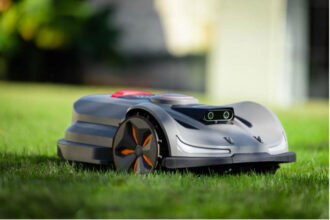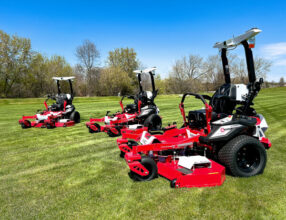Tech2Tech: EFI Update
By Dave Worden
In a previous series of articles on Electronic Fuel Injection (EFI) in OPE, I covered basic terminology, open loop and closed loop operation and all of the acronyms associated with EFI systems. As you may recall, I also combined the systems used by Kawasaki (open loop) and Kohler Engines (closed loop). In this update, I will cover some additional changes and features used in the Kohler EFI system.
The original Kohler EFI system had the following components: Intake Manifold, Battery Ignition Coil, Throttle Position Sensor (TPS), Engine Temp Sensor, Fuel Injector and an Electronic Control Unit (ECU). It also had an Oxygen Sensor that helped it to go to closed loop.
Two newer components that will be incorporated in this system are as follows: Manifold Absolute Press (MAP) and Inlet Air Temp (IAT).
Review of an open loop system
Let’s review how the open loop system operates in its most basic form. The ECU monitors primary sensor signals and compares them to pre-programmed “maps” to manage fuel delivery and spark. A “map” is a predetermined amount of fuel and air to be ignited based on starting and running conditions. It then tries to achieve the ideal mixture dependent upon the throttle position and load.
Closed loop operation
To go to a closed loop operation, you add an oxygen sensor in the exhaust system and tie it back to the ECU. Based on information supplied back to the ECU by the various components, the ECU adjusts the fuel and spark to get the “ideal” burn and run more efficiently and effectively. To accomplish this, the Engine Temperature Sensor tells the ECU that the engine has warmed up sufficiently; memory in the ECU will adapt and store running information.
The other thing to keep in mind is that the engine must be in a “Steady State,” which means the engine is not accelerating or not starting. The ECU needs to run in a rich mode when it is cold just for starting. Once the engine goes into closed loop operation, it has an adaptive learning process and tries to learn its environment.
One piece of additional information is that the unit will go to “short-term” adaption once the engine is warmed up to 140 degrees Fahrenheit (60 degrees Celsius). When the engine reaches 176 degrees F (80 degrees C), long-term adaption begins.
Figure 1 — Electronic Control Unit (ECU)Component review
The ECU is the brains of the system. It reads and configures all the other components and gets them to work together to achieve the ideal burn for efficiency. The unit has the following capability: internal memory features (resettable) and three hour meters (1 for current run time, 1 for permanent time, and 1 for trip meter). The ECU also controls maximum rpm; maximum voltage; maximum temperature; intake air temperature; engine temperature (oil/coolant); and the rev limiter, which will cut fuel delivery if the engine exceeds 4,500 rpm (see Figure 1).
Sequential injection (What is it?)
To be able to be truly fuel efficient, another feature to add is sequential injection. That is, the spark ignites only for the power stroke (no waste spark). Injectors only operate during the intake stroke. Batch fire is used during start-up below 600 rpm.
Sequential injection (How it works)
The speed sensor locates the missing tooth on the flywheel to indicate the crank position. The MAP sensor then identifies a sudden pressure drop located near the cylinder head to indicate the proper stroke and then controls the spark and fuel to accomplish the function.
Throttle Position Sensor (TPS)
The Throttle Position Sensor (TPS) is the primary detection of acceleration and secondly monitors throttle position as a way to detect load. Think of it as a variable resistor. If removed or damaged, it resets. Refer to the service manual for procedure (see Figure 2).
Figure 2 — Throttle Position Sensor (TPS)
Oxygen Sensor
The Oxygen Sensor uses a catalyst to generate voltage 0.1 v (Lean) to 1.0 v (Rich). This unit measures the oxygen content in the exhaust. The Heater enables activity in less than 8 seconds. It has individual grounds for both sensor and heater.
The Oxygen Sensor carries fuel to the injectors under pressure resistant to exhaust poisoning. This is a change from the earlier version; some of the earlier units would load up and become lazy, causing adaption issues (see Figure 3).
Figure 3 — Oxygen Sensor
Engine Temperature Sensor
The Engine Temperature Sensor is used to sense oil or coolant temperatures. It is a sensitive resistor and changes resistance as temperature varies, altering the 5-volt signal sent to the ECU. The ECU uses this signal to help determine correct fuel mixtures, such as cold starting, warm-up, closed loop, and ignition timing (see Figure 4).
Figure 4 — Engine Temperature Sensor
High-pressure Fuel Line
High-pressure Fuel Line carries fuel to the injectors under pressure formerly known as the fuel rail.
Ignition Coils
Ignition Coils are high-voltage solid-state battery ignition. The ECU controls spark timing through the ground side of the primary circuit. The ECU determines spark timing based on speed, load and engine air temperature (see Figure 5).
Figure 5 — Ignition Coil
Fuel Line
There is a slight change here as well. Before the Fuel Pump Module (FPM) used 6.5-mm (1/4-inch) low-pressure fuel line SAE R7 low permeation. After the FPM, use high-pressure fuel line SAE R9 low permeation or R12. Use screw-type or Oetiker clamps made for high-pressure EFI systems.
Fuel Filter
A plastic case filter is installed before the pump (Kohler Part #25 050 02-S). It is a 10-micron screen that needs to be replaced every 200 hours for optimum efficiency (see Figure 6).
Figure 6 — Fuel Filter
Manifold Absolute Pressure Sensor (MAP)
This component has been added to the manifold and functions as follows: It monitors pressure in the manifold as the primary means to detect load. It works as an absolute pressure transducer and reports instant barometric pressure reading when the key is turned “on.” This sensor works with a 5-volt signal from the ECU. Located between cylinders, the sensor has a brush that moves across a carbon strip to change resistance. It works off a 5-volt signal from the ECU (see Figures 7 and 8).
Figure 7 — Manifold Absolute Press (MAP)
Figure 8 — Intake Manifold
Inlet Air Temperature Sensor (IAT)
The Inlet Air Temperature Sensor (IAT) detects the air temperature entering the manifold and is used with MAP information to calculate air density.
Ignition timing will adjust to prevent detonation caused by warm air intake (see Figures 9 and 10).
Figure 9 — Inlet Air Temp (IAT)
Figure 10 — Throttle Body with IAT
Electric Fuel Pump Module (FPM)
The Electric Fuel Pump Module (FPM) is also a new addition and can be either a standard mechanical or impulse pump used to deliver fuel from the tank to the rest of the fuel system. The modules deliver 39 psi (2.7 bar) system pressure, and the fuel pumps are non-serviceable. Internal check valve holds system pressure after the key switch is turned “off.” The modules are engine mounted and must be replaced if a problem is suspected.
Note: Warranty will be denied if tamper-proof mushroom is removed (see Figure 11).
Figure 11 — Electric Fuel Pump Module
A closed loop system is a little more costly up front, but over the long haul, the cost savings in fuel, service intervals and less downtime outweigh the initial costs. As technicians, it would be in your best interest to attend any seminars that are being presented. And, as always, when in doubt, refer to the service manual; it is one of the most valuable tools in your collection.
Dave Worden has 40 years of extensive experience in the outdoor power equipment industry at the dealer, distributor and manufacturer levels. After beginning his career as a service technician for a dealership, he made the jump to a Central Distributor. There, he continued to work in the service department before he was promoted to educational director, representing Briggs & Stratton, Kohler, MTD and Tecumseh. He then moved up to the manufacturer level, serving as a territory manager for McCulloch Corp., a training specialist for Kohler Co. Engine Division, and a general manager for a manufacturer-owned dealership. In addition to being a contributing writer for OPE magazine, Worden is currently a program director for SkillsUSA.



